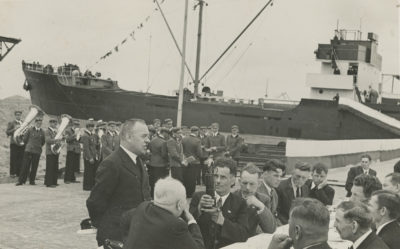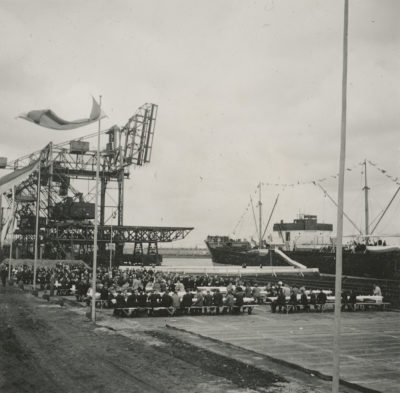Blessing of the Ship “Robur VIII” (31 objects)
In the first years after Poland regained independence, the development of the Polish merchant fleet was slow. The operation of the shipping companies which were established was unstable. The situation only improved in the late 20s. of the 20th century when the state became directly involved in its expansion. In 1927, the “Żegluga Polska”/“Polish Navigation” (ŻP) Gdynia state company was established. In the following year, “Polbrit” or Polish-British Shipping Partnership was founded.
Apart from the state capital, a private investment also contributed for the development of the Polish merchant fleet. In 1927, the Uppers Silesian “Robur” industrial concern founded the Polish-Scandinavian Transport Society “Polskarob”. The foundation of the company was a result of an agreement signed by the Polish government and the “Robur” concern. The agreement concerned the area on the Swedish Quay being leased to the concern. In exchange, it was supposed to develop the quay and start its own fleet which would sail under the Polish flag.
The company’s CEO was Alfred Falter MSc. Initially, foreign capital was the largest shareholder of the company. Then, most of the shares were taken over by Falter himself. Initially, the company’s headquarters was located in Świętojańska Street in Jacobini’s house. In 1935, “Polskarob” built its own seat in Kamienna Góra in 8/10 Korzeniowskiego Street.
The company had its own fleet of ships which transported coal to Scandinavian ports. All the vessels’ names were “Robur” with consecutive numbers in Roman numerals (I to VIII). In total, 8 of such bulk carriers were in use.
In Gdynia City Museum’s collection there is a photo album with 31 photographs of the blessing ceremony for the last vessel of this shipowner – “Robur VIII”. It was constructed in the Scottish shipyard Burntisland. The 92.88 m long and 13.56 m wide vessel was capable of transporting 4,300 tonnes of coal.
During the war, the vessel ended up in Great Britain, just as all “Polskarob’s” ships and its name was changed into “Zagłoba”. Unfortunately, in February 1943, Zagłoba (the former “Robur VIII”) went missing at sea, when it was a part of a convoy from the USA. There was a crew of 27 on board, supervised by Captain Zbigniew Deyczakowski. This was the biggest loss for the Polish Mercantile Marine during World War II.
The photographs in the album were taken by Ernest Raulin who worked for the Maritime Office. His photographs were published in pre-war Gdynia guidebooks, for example “Przewodnik – Informator Turystyczny po Gdyni i Wybrzeżu” (“Guidebook of Gdynia and the Seaside”). In Autumn 1939, Raulin turned out to be a traitor and passed on the photographs of Gdynia’s citizens who were on proscription lists to Germans. After the war, he was put on trial and sentenced to prison.























 Show more
Show more